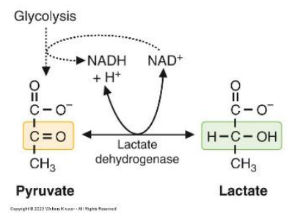POST Energy Metabolism
1/13
There's no tags or description
Looks like no tags are added yet.
Name | Mastery | Learn | Test | Matching | Spaced |
|---|
No study sessions yet.
14 Terms
ATP
All the ribonucleotides can be used for energy by proteins (ATP, GTP, CTP, UTP)
Each of the 3 phosphate bonds are high energy bonds
They are easily broken by enzymes, allowing reactions with other molecules or proteins, changing conformations, or reactants.
However, to synthesize ATP, cells need to harness energy from breaking other chemical bonds.
ATP Generation
Breaking the bonds in other molecules (carbs, lipids, proteins), allows proteins to harness that energy to make ATP. This energy is used for all other processes in the cell.
Each heartbeat uses about 2% of the heart’s available ATP. If the heart were not able to regenerate ATP, all its ATP would be depleted in less than 1 minute.
Electron Carriers and Movement of Electrons
Energy is stored within chemical bonds, which are shared electrons between atoms.
When electrons are moved within a cell between proteins, energy is being moved
In the cell, electron carriers include
NAD+/NADH
NADP+/NADPH
FAD+/FADH2
Enzymes from vitamins are needed to do this transfer of electrons.
Where does Glycolysis Occur?
Glycolysis occurs in the cytoplasm and does not require the mitochondria.
How is ATP Produced in Glycolysis?
The ATP is produced by substrate level phosphorylation (a phosphate from a high energy intermediate of glycolysis transfers a phosphate to ADP)
First Step of Glycolysis
Conversion of Glucose to Glucose 6 Phosphate.
This traps the glucose molecule inside the cell as only glucose can leave the cell, not G6P.
The only place this step can be reversed is in liver cells
G6P will be used by the cells to generate energy via glycolysis, be stored for later (ex: glycogen in liver and muscle cells), or be used to make new molecules.
End Product of Glycolysis
Glycolysis is a 10 step process that generates 2 Pyruvate, 2 NADH and a net total of 2ATP (gross of 4).
Fructose and Galactose Energy
Fructose and Galactose are converted to intermediates of this pathway and used in the same way as glucose
Fructose is converted to DHAP and glyceraldehyde-3-phosphate
Galactose is converted to glucose-6-phosphate
Regulation of Glycolysis
Energy metabolism is regulated to maintain energy levels within the cell
In glycolysis, the increased conc. of ATP or other metabolic products (G6P, citrate, acetyl CoA, etc) turn off the enzymes through binding to their active site or allosteric sites.
Increased concentration of energy metabolites that indicate low energy reserves (AMP, ADP), turn on the enzymes to replenish energy.
The Fate of Pyruvate
Pyruvate is a branching point in metabolism.
Pyruvate’s fate depends on the availability of oxygen.
In cells with a mitochondria, and where oxygen is available, pyruvate will be converted into acetyl CoA and enter the TCA cycle.
In the absence of mitochondria and/or oxygen, pyruvate will be converted to lactate.This conversion to lactate, regenerates NAD+ to be used in glycolysis.
Anerobic Metabolism
Glycolysis needs a supply of NAD+ to generate ATP from glucose
If NAD+ is depleted, pyruvate can be converted to lactate, allowing glycolysis to continue
This generates lactate, which can build up in the tissues.

Metabolic Acidosis in Anerobic Respiration
Anaerobic metabolism is often associated with lactic acidosis. This is a misnomer, as lactic acid is never generated.
Metabolic acidosis may or may not occur when lactate levels are increased. This depends on mitochondrial dysfunction.
Acidosis is caused by the cell using up ATP (ATP → ADP + P + H+), and the mitochondria is not there to use up the excess protons because we are not doing the TCA cycle.
This is important because lactate is not always associated with acidosis
What Tissues Use Anerobic Respiration?
Certain cells and tissues have evolved to function without mitochondria
Ex: Because RBC’s are responsible for oxygen transport, it is beneficial for them to generate energy anaerobically (they lack mitochondria)
The tissues in the eye need to be free from light deflecting structures such as mitochondria and obtain most of their energy anaerobically as well.
In skeletal muscle, when energy demand is high, anaerobic respiration will kick in to help meet demands
These processes will generate lactate.
Much less ATP is generated by anaerobic respiration which uses glycolysis (in cytoplasm)
Tissues with low oxygen, or few to none mitochondria, must use this method. They generate lactate. These tissues can overcome this inefficiency by producing MANY more glycolytic enzymes to increase reaction rates.
Hypoxic tissues can use this pathway as well, in the short-term, until oxygen delivery is restored. This is why lactate in the blood is used as an indicator of tissue perfusion.
What Happens to Lactate?
Lactate that is used for anaerobic metabolism is taken in by the liver and converted back to glucose.
The glucose can then be returned to the blood to be used as energy.